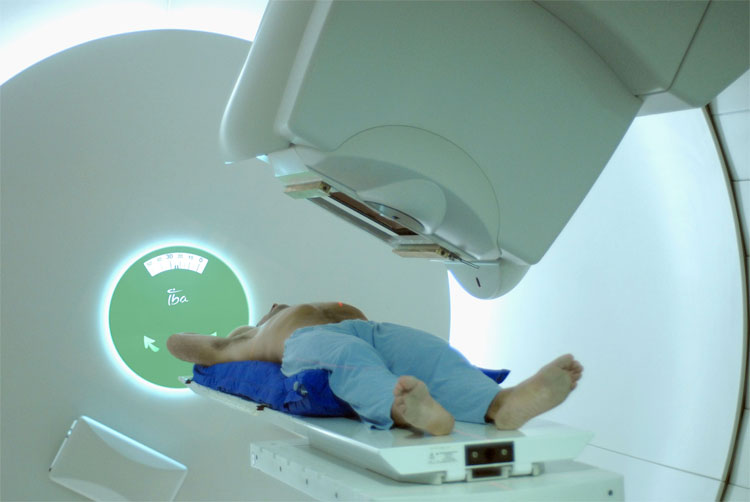Super expensive proton cancer treatment exploded in China
Recently, wealthy Chinese people have raised up the trend of treating cancer with proton therapy.
According to MIT's Technology Review Magazine, using proton therapy - a highly accurate form of radiation therapy - to treat cancer for the "booming" rich in China. Since there is no basis to support this treatment method, so far in China, there are more than 43 projects, the center supports proton therapy therapy sprouting.

So far in China, there are more than 43 projects, the center supports proton therapy therapy.
Zeng Xianwen, a radiation oncologist, who has 60 years of experience in the field, says proton therapy is a positive treatment but warns that this is not an absolute treatment. with cancer patients.
Proponents argue that projecting proton beams is better than conventional radiotherapy using X-rays because protons transmit most of its energy to tumors and less damage to healthy tissues in pulses. around. Researchers (including Mr. Zeng) are seeking to further improve this treatment by minimizing the impact on the skin and other tissues where the radiation passes before reaching the tumor.
However, current proton studies are still very limited and scientists believe that more investment is needed in these areas. For example, a 2014 study of brain tumor survivors supported the idea that proton therapy may improve the patient's quality of life when compared to the results of radiation. normal treatment. This therapy promises to bring good results in the treatment of brain tumors in children, breast cancer, neck cancer and lung cancer. But these studies are based on relatively limited data and its authors say the final conclusion may be different when they collect and evaluate more data.

Construction of proton treatment centers is much more expensive than conventional irradiation rooms.
Construction of proton treatment centers is much more expensive than conventional irradiation rooms . Experts say it takes hundreds of millions of dollars to build such a center. Even the most compact system can consume up to $ 25 million to $ 30 million.
Instead of deriving from the needs of the medical community, these centers have grown up in the direction of economic development in China. Investors realize that areas such as real estate, manufacturing are increasingly making profits less than investing in health. Therefore, a wave of investment in health services is booming in China. Typically, APH Medical invests up to 240 million USD in a proton therapy center in southeast China.
This wave was created in part by a policy of encouraging investors to pour money into health by easing the Chinese government's regulations on imports of medical equipment in 2015. This makes buying. Shopping for proton machines is easier than ever.
Some people are concerned that the development of these centers may increase disparities in health care between the rich and poor in society. On average, a proton therapy treatment in Shanghai costs over 40,000 USD. The patient must pay the full cost because the health insurance provisions do not include proton therapy treatment.

Some hospitals have partnered with investors to build proton centers but they have very few experts in this area.
The professional issue of staff at these centers also makes many people worried. Some hospitals have partnered with investors to build proton centers but they have very few experts in this area. Hu Yimin, who works for the Chinese Academy of Medicine's Cancer Hospital, said: "We should develop proton therapy but should not rush like that."
Chao, a 28-year-old girl in China, told reporters about her proton therapy therapy journey. In 2014, the doctor said that the rare tumor on the bottom of her skull had grown again after surgery. A doctor suggested that she use proton therapy that was not yet available in China.
She spent nearly $ 30,000 to go to Japan to treat with this therapy. Her tumor results stopped growing and she is now able to return to her full-time job.
- Russian scientist finds a unique way to cure cancer
- The 10 most expensive supercomputers on the planet
- Dangerous cancer - cause and prevention
- Promising breakthrough in research on cancer treatment vaccine
- How is cancer treated?
- New breakthrough in immunotherapy for immunotherapy
- What is metastatic cancer?
- America: Detecting new antibodies that treat 7 types of cancer
- For the first time, implant successful cancer treatment beads in Vietnam
- 10 things to know about cancer chemotherapy
- X-ray interference, a turning point in cancer treatment
- There has been a new breakthrough in bowel cancer treatment
 Why is Australia the country with the highest cancer rate in the world while Vietnam ranks 100th?
Why is Australia the country with the highest cancer rate in the world while Vietnam ranks 100th? New drug causes cancer to 'starve'
New drug causes cancer to 'starve' Common cancers in men
Common cancers in men America's incredible discovery: The most feared cancer cell is love
America's incredible discovery: The most feared cancer cell is love The most expensive medical machine in the world, known as the god of cancer
The most expensive medical machine in the world, known as the god of cancer  Atoms are 7 times smaller than we have ever known
Atoms are 7 times smaller than we have ever known  Physicists plan to seek antimatter
Physicists plan to seek antimatter  Russia successfully launched the Express-AM8 telecommunications satellite
Russia successfully launched the Express-AM8 telecommunications satellite  Russia successfully launched Proton-M missile
Russia successfully launched Proton-M missile  Russia announces the cause of the Proton-M rocket explosion
Russia announces the cause of the Proton-M rocket explosion 